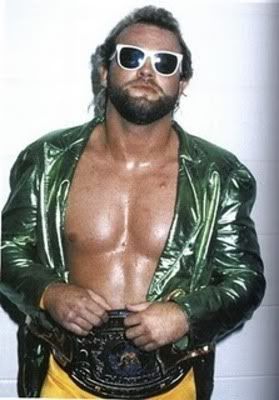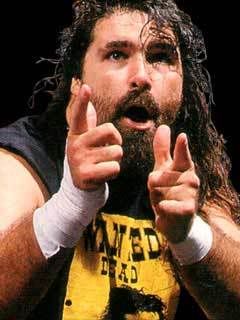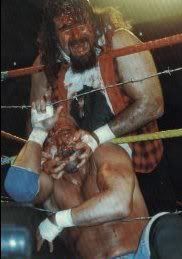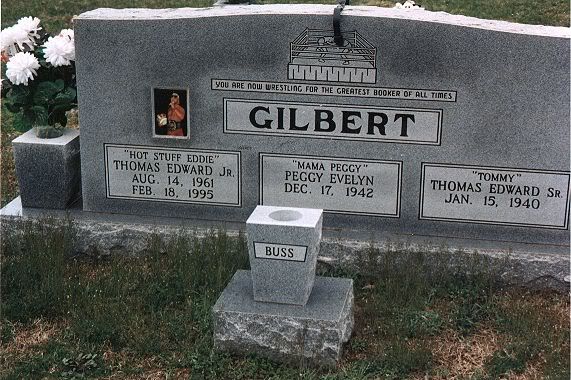wrestling / Columns
Going Broadway 02.28.12: Eddie Gilbert vs. Cactus Jack: The Punishing Feud of 1991

By 1991, “Hot Stuff” Eddie Gilbert and Mick Foley were both at a crossroads of their respective careers, although both might not have known it at the time. Gilbert, who had begun his career in 1979 had risen through the ranks of Mid-South Wrestling and UWF as both a wrestler and booker. By 1988, he had joined WCW, but his stability and status as a burgeoning main event star quickly withered as a result of (guess what) backstage squabbling and “cloak and dagger” tactics (which also caused him to lose the influence he had as a booker for the company). Not to say he didn’t have quality matches during this period, such as his work with Brian Pillman, but Eddie Gilbert by 1990 had become a disillusioned mid carder whose marriage to Missy Hyatt was all but over. He left WCW and headed back to the Indys in an attempt to revive his career…
Foley, whose career had begun in 1983, was a journeyman, as well, throughout his first five years in the business. By 1988, he had debuted his character Cactus Jack for Championship Wrestling Association in Memphis, Tennessee, but was soon on the move to WCCW and eventually WCW where he actually competed at a Clash of the Champions event against Mil Mascaras. But Foley’s first stint with the company was short lived even though his character of Cactus Jack had gained a considerable following in the wrestling community. Like Gilbert, Foley was a talent squandered by WCW and looking for greener pastures by 1990…
The parallel paths of Gilbert and Foley converged in Philadelphia, Pennsylvania that same year as part of Tri-State Wrestling Alliance (which later would become Eastern Championship Wrestling and eventually the notorious and legendary Extreme Championship Wrestling). Under the leadership of Joel Goodhart, TWA had brought a higher octane, more volatile style of hardcore wrestling to Philadelphia, which was in sharp contrast to the standard product of WWF and WCW they were used to at the time.
Goodhart gave the Philly fans what they had wanted for years in terms of a quality wrestling show that was unpredictable and very in-your-face. Most of the shows would be housed in small venues like high school gyms, but for the larger shows he would do quarterly, Goodhart would pack in the Philadelphia Civic Center.
During the course of their stints in WCW, Gilbert and Foley had already faced one another but with their distinctive hardcore, brawling styles watered down, the results were barely a footnote in the WCW record book. But in Philadelphia, the climate was different, and Foley could relish in his role as a “gloried stunt man” (as Ric Flair once insultingly referred to Foley) while Gilbert could utilize his roots as a southern brawler.
Gilbert, himself, was instrumental in booking his series of matches with Foley, but it was Goodhart, so impressed with their first match together as part of the September show of 1990, that he favored a series of matches between Gilbert and Foley throughout 1991. The first would be a Falls Count Anywhere match that would take place on March 2, 1991.
As Foley remarked in his autobiography Have a Nice Day!, he considered the Falls Count Anywhere match to be the best of his career up to that point. And Goodhart agreed, bringing both Gilbert and Foley back for a Barbed Wire match on May 18. Foley was excited despite the punishment that would result from such a match. As Foley also remarked in his book, he wanted the match to be special and stand out from the rest on the card. Therefore, he reached an agreement with Goodhart that there would not be any juicing before their Barbed Wire match that night. (Goodhart’s shows were known for lots of juicing and blading throughout many, sometimes all matches on the card)
The night of the May 18th show, Foley sat in the locker room but was perplexed when multiple wrestlers were returning to the back with blood on their forehead. What Foley found out was that Goodhart had booked a ten man “Last Blood” battle royal, where the last guy to bleed would win.
“Immediately, I ran out and caught the last five minutes of one of the sorriest affairs I’d ever seen. Ten guys, some of them had never had match before, were fighting in and around the ring. They were trying to poke, prod, gig, hit, and bust one another and themselves in an attempt to draw blood.” (Foley from Have A Nice Day)
Gilbert and Foley pushed their match to the absolute limit. Literally, the referee had to stop the match because Foley had become so badly entangled in the barbed wire that he could not compete any longer. Of course normally a Philadelphia crowd would riot over such a decision, but not this time. The effort given by Gilbert and Foley had earned their respect and admiration. Gilbert passed out in the back from blood loss and exhaustion, while Foley was greeted by his wife.
The Barbed Wire match had served its purpose for TWA. The feud between Gilbert and Foley was gaining not only local but national attention as well as one of the biggest of the year. Goodhart knew a third act had to eclipse both of the previous matches. Something that would solidify this battle between Gilbert and Foley as the feud of the year above all else: A Best of Three Falls match. Goodhart raised the stakes by making each match in the three a special gimmick match as well.
Gilbert and Foley worked out the specific gimmicks of each fall, settling on fall one being a Falls Count Anywhere match, fall two being a Stretcher match, and the deciding third fall (if necessary) a Steel Cage match.
The result on August 3rd was considered by many, including Gilbert and Foley, as the best match of their career…
…
1st Fall – Falls Count Anywhere: Time, approximately 10 minutes From the get go, Foley dominates in the ring, even scoring with the Double Arm DDT (great bump by Gilbert, by the way) within the first couple of minutes. Predictably, the action heads to the outside quickly. Foley takes one of his classic back body drop bumps on the floor to swing the momentum toward Gilbert. From that point, they tour the Civic Center, trading chair shots in the process. Gilbert is busted open quickly, but he scores with a suplex and a pile driver through a table. There’s also a great moment in this fall where Gilbert grabs a tray of concession items and chucks its contents at Foley. (It always seems to be a badge of honor for wrestlers to take the concession items you’ve paid for and use them against their opponent. Everyone seems to enjoy it. Just once I’d love to see some miser who splurged for food and drink to take umbrage and be owned by a wrestler when they confront them.)
A great Foley spot is when he breaks out his diving cannonball flip from the apron to the outside floor. It’s clear he’s in the best shape of his life for this match, as he also wrote in his book. Gilbert scores two Hotshots to Foley (one on the guardrail and one on the top rope), but after the second he tries to follow it up with another pile driver, which Foley reverses with a back body drop to the outside floor. This sets up Foley for a diving clothesline from the apron which gives him the three count. Winner: Foley
Gilbert gives an impassioned Mickey Rourke-esque statement from The Wrestler that if he loses again, he’ll retire that night from TWA.
2nd Fall – Stretcher Match: Time, approximately 10 minutes Foley makes his entrance quickly, but Gilbert’s is delayed as he continues to get bandages from the doctors. Not a problem for Foley as starts the match near the entrance way. Gilbert is bleeding again within moments (so much for the bandages). Foley dominates the match early on, and eventually gets Gilbert back to the ring. He scores on multiple bulldogs and drives Gilbert back to the outside near the stretcher. The pivot in the match comes when he leaps from the second turnbuckle to the outside, but the angle of the video doesn’t really show how much he connected with Gilbert or if he connected at all because it’s Gilbert who gets up first and takes over. And when I say take over, I mean he goes into “whatever the fuck it takes” mode.
He takes a large trash bin Foley had been using earlier but doesn’t stop with a couple of bashes to Foley’s head. He empties the contents, finding a beer bottle inside which he clearly needs to find the other half of after breaking it over Foley’s head (favorite line from Happy Gilmore). Gilbert uses the half of the bottle he still has possession of (since he couldn’t find the rest of it) and jabs it into Foley’s forehead, drawing a considerable amount of blood. He follows with a pile driver and a DDT on the outside floor, icing the assault with repeated bashes of the ring steps. Foley is carted off on the stretcher, giving the second fall to Gilbert. Winner: Gilbert
Gilbert once again grabs the microphone and proclaims there will be a third fall in this main event, which a Keith David-looking gent from Pitch Black is delighted to hear from the front row.
3rd Fall – Steel Cage Match: Time, approximately 15 minutes After the vicious beating he gave Foley in the Stretcher Match, Gilbert struts around the ring, working the mic to fill time before Foley’s entrance. Gilbert quickly reverses his earlier proclamation of a third fall by saying there will not be a third fall after all because Foley will not be able to compete. (No visual of Keith David to get his reaction to this update)
Once the cage is fitted around the ring, Gilbert awaits Foley’s entrance, but he doesn’t emerge after repeated playings of his Steppenwolf theme music. Gilbert gets a lot of heat (and a lot of pops) during this time as he works the mic more and more. Finally, Goodhart comes on the mic and makes the official statement that Foley cannot complete in the cage match. But wait, oh wait. The Steppenwolf music plays once more, and Foley emerges with his head now heavily bandaged. He gets on the mic now, stating the doctors cannot license the match because he’s too badly hurt to which one fan responds with a very audible “Bullshit!” But do not fear, sir. Foley has little regard for matters such as a doctor’s consent or advice. He enters the cage, and the third fall begins. Once again, Foley gets the early advantage and introduces Gilbert to the cage walls more than a couple of times.
I won’t lie, there seems to be a little bit of confusion regarding the rules of this cage match as it moves along. The traditional cage match has the winner escaping either over the top of the cage or if there is a door available in the design. Amendments to the rules added a referee to make pin falls or submissions as another path to victory as well. This match clearly has a referee, and it looks like the wrestlers are cognizant of the “escape” clause as evidenced when Foley scales one of the walls of the cage. He doesn’t turn around like he’s about to go Superfly style on Gilbert. He looks like he’s about to escape or at least try to. But Gilbert halts his progress, and this is where something seems to be off in the match. He drop kicks the side of the cage, sending Foley crashing to the outside floor (a nice foreshadow to Hell In The Cell 1998). But the bell doesn’t ring. In fact the ref on the inside and the ref on the outside look at each other as if to say “oh, shit.” Was it a botch? Was it planned? I don’t know. Even the commentator admits he’s confused by the rules. But quickly the ref opens the door and the match seems to pick up where it left off. The commentator reassures us, as if someone just handed him a note, that the only way to win is by pinball or submission.
But Gilbert and Foley don’t go back in right away. They fight on the outside and into the crowd again. (The Keith David fan can be seen at this point. He’s traveled to another section of the arena.) But once they’re back inside, Gilbert takes one of the chains from the cage and uses it to choke out and beat down Foley, who returns the favor when he gets access to chain as well. Both men are faces full of blood as there just seems to be no end in sight for the assault they carry out on one another. The commentator makes a comment that only a couple hundred fans remain in the crowd, exhausted from the mayhem that’s ensued; some even calling for the match to be stopped. (This is not really audible on the video, though.)
The pivot in the match comes when Gilbert clotheslines the referee out of his shoes (a shot that reminds me of one of Stan Hansen’s “fuck you” lariats) which allows Doug Gilbert to run out and join the fray. They beat down Foley for awhile until Bam Bam Bigelow hits the ring, forcing the brothers GIlbert to scatter. An announcement is then heard that the referee has ruled the match a double disqualification (?) with the fans becoming livid and chanting “bullshit” as a response (which is why I doubt the creditability of the above claim that fans wanted the match to be stopped). Winner: No Contest
…
The feud by the end of the night was a push; undecided in terms of an overall victor. But the fortitude displayed by both Gilbert and Foley put the Best of Three Falls match in a unique five-star match position. Of course when you compare it to Flair-Steamboat or even Hart-Michaels at Wrestlemania it pales in comparison. Nevertheless it succeeds in taking the audience on literally a three-act journey that was both brutal and punishing yet very accessible to the fans, which historically shows, in the bigger scope of the business, where wrestling was headed by the middle and end of the 90’s: unpredictable, high octane violence sandwiched in between the occasional arm drag takedown and grapevine submission.
In terms of Gilbert and Foley, their series of matches throughout 1991, including the epic Best of Three Falls match, attracted the attention of the wrestling world, and WCW made offers to both men to rejoin their ranks. However, it was only Foley who would accept the invitation. Gilbert, fearing he would be relegated to the same mid card status he was before, declined. WCW had hoped to revive their feud from TWA on their larger stage, but Gilbert also feared that WCW would water down their quality of matches and diminish the legacy they had created in TWA.
Foley’s second stint in WCW would elevate him into high profile feuds as a heel with both Sting and Ron Simmons (among others) as he continued his Cactus Jack character. But of course it wasn’t until he was signed by the WWF in 1996 that he ultimately reach main event status, become World Champion on multiple occasions, write best selling books, and hawk ravioli. Since returning last year to the company, he is now poised to become a member of the Hall of Fame in years to come.
After the feud with Foley in 1991, Gilbert continued to bounce around between independent promotions while also working shows in Puerto Rico on occasion. Unfortunately he had developed a bit of a reputation for flaking out on shows and burned numerous bridges with promoters. One of his last big feuds was a revival of one of his previous wars with Jerry Lawler in the Memphis territory, which included some of the strongest promo work of his career (which many of it was borderline shoot) and helped bring new fans into a very historical promotion.
By 1995, after an unsuccessful stint in Smokey Mountain Wrestling, Gilbert resumed work in Puerto Rico with the World Wrestling Council; this time assuming a booking role as well. On February 17, Gilbert wrestled his last match, not against Foley or Lawler or even some no-name jobber. He wrestled a bear…
Afterwards he retired to his apartment, but sadly was found dead the next day of a heart attack. Eddie Gilbert was 33 years old. The combination of residual effects stemming from a 1983 car accident along with a strong dependency on painkillers contributed to the tragic, early demise of one of wrestling’s most recognizable stars.
Although Gilbert never achieved main event status in the WWF or WCW, and Foley most certainly went on to have higher profile matches in the business, the work they did together in that transitional period of 1991 holds its own special place in the pantheon of professional wrestling. Two men from different backgrounds that had that unique chemistry that not everyone can have with an opponent.







